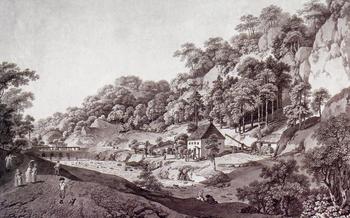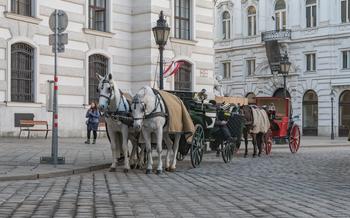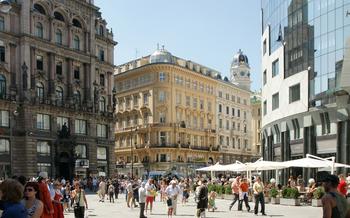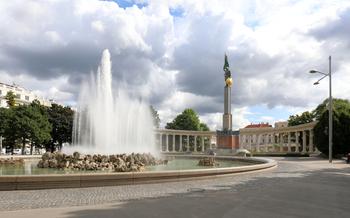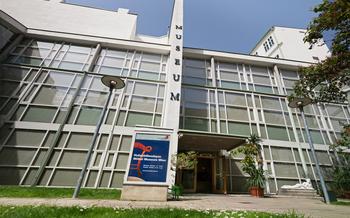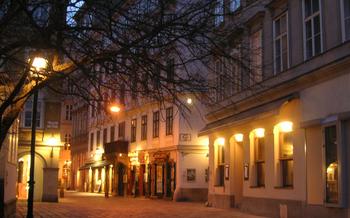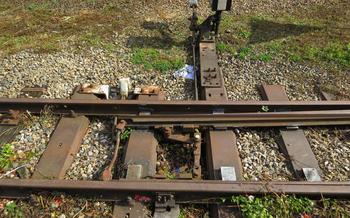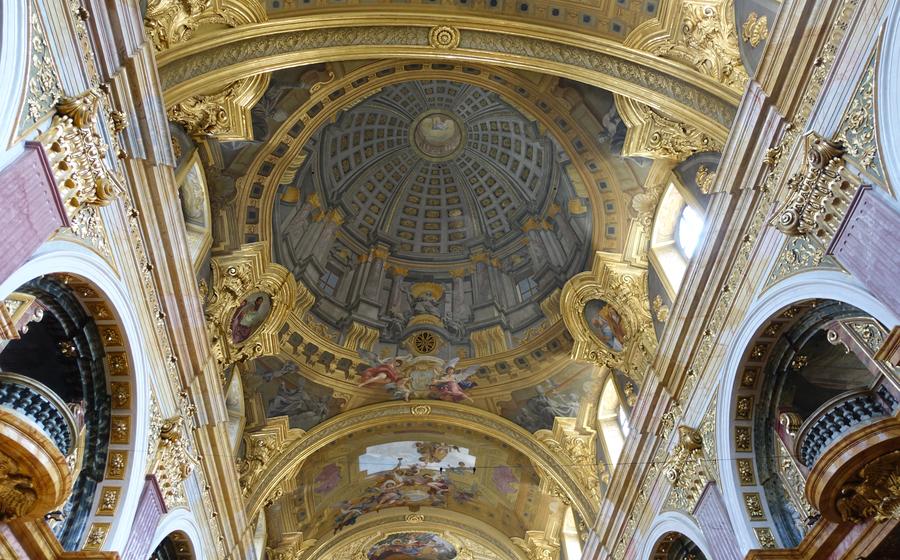
Church of the Jesuits
- Historical Significance
- Architectural Masterpiece
- Interior Highlights
- Spiritual and Religious Significance
- Music and Concerts
- Guided Tours
- Location and Accessibility
- Opening Hours and Admission
- Dress Code and Etiquette
- Photography and Videography
- Nearby Attractions
- Local Restaurants and Cafés
- Souvenirs and Gift Shops
- Events and Festivals
- Insider Tip: Unveiling a Hidden Gem
Historical Significance
The Church of the Jesuits, also known as the Jesuitenkirche, holds a significant place in the history of Vienna and the Catholic Church. Its origins date back to the 16th century when the Jesuit order, founded by Ignatius of Loyola, arrived in Vienna. With the support of the Habsburg dynasty, they established a college and a church on this site. The church, designed by prominent architects like Andrea Pozzo, was completed in 1631 and became a prominent Jesuit church in Vienna. During the Counter-Reformation movement, it played a crucial role in promoting Catholicism in the region. Despite facing challenges, including the Turkish siege and World War II, the church has survived as a testament to its historical and architectural importance. Today, it stands as a spiritual and cultural landmark in the heart of Vienna, attracting visitors from around the world.
Architectural Masterpiece
The Church of the Jesuits stands as a testament to the grandeur of Baroque architecture, captivating visitors with its intricate facade and awe-inspiring interior. Designed by the renowned architect Andrea Pozzo, the church's facade boasts an array of intricate carvings and sculptures that narrate biblical stories and glorify the Jesuit order. The intricate details, including cherubs, angels, and saints, are a testament to the skill and artistry of the Baroque era.
Stepping inside the church is like entering a celestial realm, with its soaring ceilings, ornate altars, and impressive frescoes. The high altar, a masterpiece of Baroque art, is adorned with opulent decorations, gilded carvings, and a radiant painting of the Assumption of Mary. Its grandeur is further enhanced by the intricate marble inlay work and the delicate sculptures that adorn the altar's base.
The church's interior is a symphony of art and devotion, with every corner revealing another hidden treasure. The side altars, dedicated to various saints, showcase exquisite paintings and sculptures, each telling a unique story. The ceiling frescoes, painted by Andrea Pozzo, depict scenes from the life of St. Ignatius of Loyola, the founder of the Jesuit order. The illusionistic technique used in the frescoes creates a sense of depth and movement, drawing the viewer's gaze upwards towards the heavens.
The acoustics of the Church of the Jesuits are renowned, making it a popular venue for classical music concerts. The church's soaring ceilings and reverberant walls create a rich and resonant sound that enhances the performances of the Vienna Boys' Choir and other renowned musicians. Attending a concert in this sacred space is a truly immersive experience, allowing visitors to appreciate the beauty of the music and the grandeur of the architecture simultaneously.
Interior Highlights
The interiors of the Church of the Jesuits are a testament to the grandeur and opulence of Baroque architecture. Visitors are immediately drawn to the magnificent high altar, which is the centerpiece of the church. It is intricately carved with gold leaf, cherubs, and floral motifs, creating a breathtaking visual display. The altarpieces, sculptures, and paintings that adorn the interior are equally impressive, showcasing the talents of renowned artists like Andrea Pozzo.
One of the highlights of the church is the painting "The Glorification of St. Ignatius" by Andrea Pozzo, which depicts the Jesuit founder, St. Ignatius of Loyola, being received into heaven. The painting is a masterpiece of Baroque art and is known for its illusionistic style, creating the illusion of a three-dimensional space.
The ceiling frescoes by Andrea Pozzo are another must-see feature of the church's interior. These frescoes depict scenes from the life of St. Ignatius of Loyola and are executed with great skill and artistry. The vibrant colors, dynamic compositions, and intricate details of the frescoes add to the sense of grandeur and awe within the church.
Spiritual and Religious Significance
The Church of the Jesuits holds immense spiritual and religious significance for Catholics worldwide. As a prominent Jesuit church, it played a crucial role in promoting Catholicism during the Counter-Reformation and remains a symbol of the Jesuit order's dedication to spreading the Catholic faith. The church is dedicated to St. Ignatius of Loyola, the founder of the Jesuit order, and his teachings and spirituality are deeply embedded within its walls. Visitors can sense a palpable sense of peace and tranquility within the church, inviting them to reflect on their faith and connect with the divine.
Music and Concerts
The acoustics of the Church of the Jesuits are renowned for their exceptional quality, making it a popular venue for classical music concerts. The church's spacious interior and high ceilings create a resonant atmosphere that enhances the sound of musical performances. Throughout the year, the church hosts a variety of concerts featuring renowned musicians, ensembles, and choirs from around the world.
One of the highlights of the musical calendar is the annual "Jesuitenkirche Konzerte" series, which showcases a diverse range of classical music genres. From intimate chamber music recitals to grand orchestral performances, the series offers something for every music lover. Visitors can enjoy the works of great composers such as Mozart, Beethoven, and Bach, performed by talented musicians in the stunning surroundings of the church.
The Vienna Boys' Choir, one of the world's most celebrated choirs, regularly performs at the Church of the Jesuits. Founded in 1498, the choir has a long and prestigious history and is known for its exceptional vocal quality and musical artistry. Attending a performance by the Vienna Boys' Choir is a unique and unforgettable experience, allowing visitors to witness the talent and dedication of these young singers.
For those interested in attending a concert at the Church of the Jesuits, it is advisable to check the church's website or contact the church office for information on concert schedules, ticket prices, and booking procedures. Advance booking is recommended, especially for popular concerts, to avoid disappointment.
Guided Tours
To delve deeper into the rich history, architecture, and religious significance of the Church of the Jesuits, consider taking a guided tour. The church offers various types of tours, catering to different interests and preferences. Regular group tours are available at specific times throughout the day, allowing visitors to join a knowledgeable guide and explore the church's highlights. For a more personalized experience, opt for a private guided tour, where you can customize the itinerary and ask specific questions. Guided tours provide insights into the church's construction, artistic features, and the role it played during significant historical events. They also offer access to restricted areas and hidden gems that are not accessible to the general public. Whether you're a history buff, an architecture enthusiast, or simply curious about the spiritual significance of the church, a guided tour is an excellent way to enrich your visit.
Location and Accessibility
The Church of the Jesuits is strategically located in the heart of Vienna, making it easily accessible to visitors. Situated on Dr.-Ignaz-Seipel-Platz, it is within walking distance from other popular attractions such as the Hofburg Palace, the Spanish Riding School, and the Albertina Museum. Public transportation is also convenient, with the nearest metro station being Herrengasse (U3 line) and several bus stops nearby. For those arriving by car, there are limited parking options in the surrounding area, but visitors are advised to use public transportation or park in a nearby garage. The church is wheelchair accessible, featuring ramps and elevators to facilitate movement for visitors with disabilities.
Opening Hours and Admission
The Church of the Jesuits welcomes visitors throughout the week, offering ample opportunities for exploration and reflection. Its opening hours vary depending on the season and special events. During the summer months (April to October), the church is generally open from 9:00 AM to 6:00 PM, while in the winter months (November to March), it is open from 10:00 AM to 4:00 PM. Visitors are kindly requested to respect these hours and plan their visit accordingly.
Admission to the church is free of charge, allowing everyone to experience its grandeur and spiritual atmosphere without financial barriers. However, donations are gratefully accepted and contribute to the ongoing preservation and maintenance of this architectural masterpiece. Visitors who wish to make a donation can do so at the designated collection boxes located inside the church.
Please note that the church may occasionally be closed for special events or services. It is advisable to check the church's official website or contact the parish office in advance to confirm the opening hours and any potential closures.
Dress Code and Etiquette
When visiting the Church of the Jesuits, it is essential to dress respectfully, as it is a sacred place of worship. While there is no strict dress code, visitors should avoid wearing shorts, tank tops, or revealing clothing. It is advisable to dress modestly and conservatively to show respect for the religious atmosphere.
Maintaining silence and being mindful of ongoing services or events is crucial. Visitors should avoid talking loudly or disturbing others during prayers or ceremonies. It is also important to be respectful of the church's staff, volunteers, and other visitors.
Photography and Videography
The Church of the Jesuits generally permits photography and videography for personal and non-commercial purposes. However, there are certain guidelines and restrictions to ensure respect for the sacredness of the church and the privacy of visitors.
Before taking any photos or videos, it is advisable to ask for permission from the church staff or a tour guide. They can provide guidance on appropriate locations and ensure that ongoing services or events are not disrupted.
Flash photography and the use of tripods or other photography equipment may be restricted in certain areas of the church to minimize distractions and preserve the integrity of the artwork and artifacts. Visitors are encouraged to be mindful of their surroundings and avoid disturbing other visitors or ongoing religious activities.
When taking photos or videos, it is important to maintain a respectful demeanor and avoid capturing images of individuals without their consent. Visitors should also refrain from using the church as a backdrop for staged or commercial photography sessions without prior authorization.
By adhering to these guidelines, visitors can respectfully document their visit to the Church of the Jesuits while preserving the sanctity and serenity of this historic place of worship.
Nearby Attractions
A visit to the Church of the Jesuits can be seamlessly combined with other captivating attractions nearby, each offering a unique glimpse into Vienna's rich history and vibrant culture. Just a short stroll away lies the imposing Hofburg Palace, the former imperial residence of the Habsburg dynasty. Explore its grand halls, admire the imperial apartments, and delve into the fascinating history of Austria's ruling family.
Another nearby gem is the Spanish Riding School, home to the world-renowned Lipizzaner horses. Witness the grace and precision of these magnificent animals as they perform intricate dressage routines, a tradition that has been passed down for centuries.
For art enthusiasts, the Albertina Museum beckons with its extensive collection of paintings, drawings, and prints. Admire masterpieces by Dürer, Klimt, and Picasso, among others, and trace the evolution of art through the ages.
By combining these attractions with the Church of the Jesuits, visitors can create a personalized itinerary that caters to their interests and passions, ensuring a truly memorable and immersive experience in the heart of Vienna.
Local Restaurants and Cafés
After exploring the grandeur of the Church of the Jesuits, take a break and savor the flavors of Viennese cuisine at nearby restaurants and cafés. Indulge in traditional Austrian dishes like Wiener Schnitzel, Tafelspitz, or Sachertorte at renowned establishments such as Gastwirtschaft Wratschko or Zum Schwarzen Kameel. For a more contemporary culinary experience, visit Das Loft, known for its innovative fusion dishes and stunning rooftop views. Enjoy a leisurely coffee and delectable pastries at Café Central, a historic Viennese café that exudes old-world charm and elegance. With its vibrant culinary scene, Vienna offers an array of dining options to satisfy every palate and create a memorable culinary experience.
Souvenirs and Gift Shops
Near the Church of the Jesuits, visitors can find a variety of shops and stalls selling souvenirs and gifts to remember their visit. These shops offer a range of items, including religious objects such as rosaries, crucifixes, and statues of saints. Visitors can also purchase postcards depicting the church's stunning architecture, as well as books and guides detailing its history and significance. For those seeking unique souvenirs, there are shops selling handmade crafts, jewelry, and other locally produced items. Whether you're looking for a small token or a special memento, you're sure to find something to cherish among the offerings near the church.
Events and Festivals
Throughout the year, the Church of the Jesuits hosts a variety of special events and festivals that offer visitors a unique opportunity to experience its spiritual and cultural significance. These events range from religious celebrations to classical music concerts and cultural exhibitions.
One of the most notable events is the annual "Jesuitenkirche Konzerte" series, which features a range of classical music genres performed by renowned musicians. Visitors can enjoy the exquisite acoustics of the church as they listen to the Vienna Boys' Choir or other talented performers. Specific dates and times for these concerts can be found on the church's website or by contacting the church office.
During religious holidays, such as Christmas and Easter, the church holds special services and celebrations that draw both locals and tourists alike. Visitors can witness the grandeur of the church adorned with festive decorations and experience the spiritual atmosphere as the community comes together to celebrate.
For those interested in delving deeper into the history and culture of the church, guided tours are available that provide insights into its architecture, religious significance, and role in Viennese society. These tours often include access to restricted areas and personalized explanations from knowledgeable guides.
Insider Tip: Unveiling a Hidden Gem
Amidst the grandeur of Vienna's iconic landmarks, nestled just a stone's throw from the Church of the Jesuits, lies a hidden gem waiting to be discovered. Step into the charming cobblestone alley of Blutgasse and find yourself transported to a serene oasis known as the Jesuitenhof. This tranquil courtyard, once a private garden belonging to the Jesuit order, now welcomes visitors seeking respite from the bustling city.
As you enter the Jesuitenhof, the hustle and bustle of Vienna fade away, replaced by a sense of peace and tranquility. Surrounded by elegant Baroque architecture and lush greenery, this hidden gem offers a unique perspective of the city's rich history. Admire the intricate frescoes adorning the walls, each telling a story from the life of St. Ignatius of Loyola, the founder of the Jesuit order.
Take a moment to sit on one of the benches and soak in the tranquility of the courtyard. Let the gentle sound of water trickling from the fountain transport you to a bygone era. Enjoy a coffee or a light snack at the cozy Café im Jesuitenhof, located within the courtyard, and savor the flavors of Viennese cuisine in this serene setting.
The Jesuitenhof is not just a hidden gem for relaxation but also a place of cultural significance. It hosts various events throughout the year, including concerts, exhibitions, and lectures, providing visitors with an opportunity to delve deeper into the history and culture of Vienna. Check the church's website or inquire at the church office for more information on upcoming events.
So, as you explore the wonders of the Church of the Jesuits, don't miss the chance to seek out this hidden gem. Discover the charm of the Jesuitenhof, immerse yourself in its tranquility, and uncover a hidden gem that will leave you with lasting memories of your visit to Vienna.

